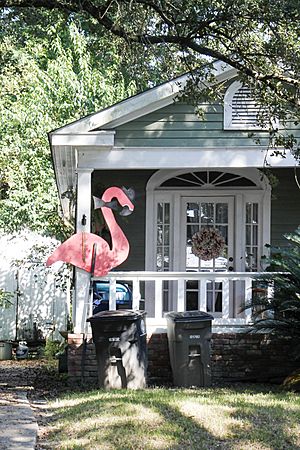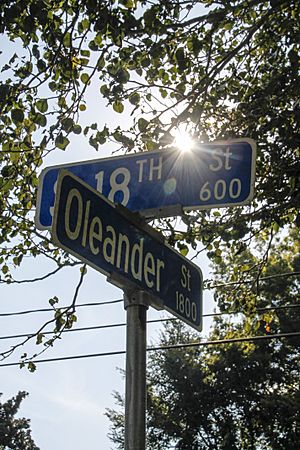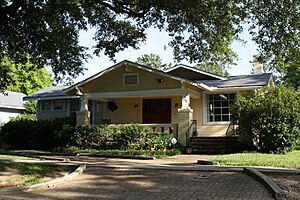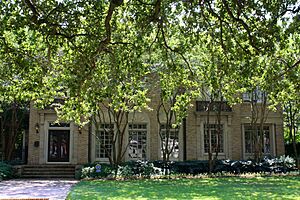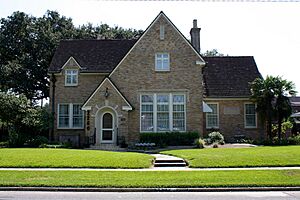Garden District, Baton Rouge, Louisiana facts for kids
The Garden District is a special neighborhood in Baton Rouge. It's known for its beautiful old homes and friendly community. This area is actually made up of three smaller historic districts: Roseland Terrace, Drehr Place, and Kleinert Terrace.
A historic district is a special area recognized by the National Register of Historic Places. This means its buildings and history are important to the country.
Contents
Roseland Terrace Historic District
Quick facts for kids |
|
|
Roseland Terrace Historic District
|
|
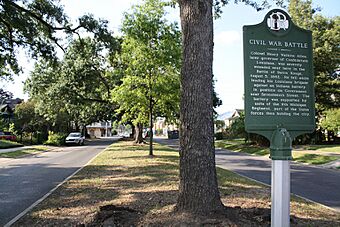 |
|
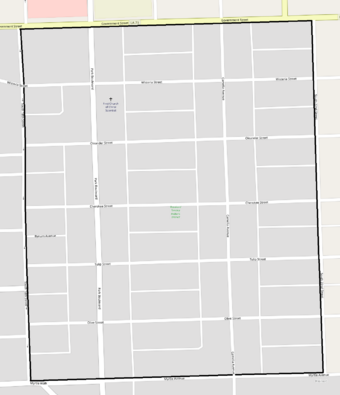 |
|
| Location | Bounded by Government Street, South 18th Street, Myrtle Avenue, and South 22nd Street, Baton Rouge, Louisiana |
|---|---|
| Area | 65 acres (26 ha) |
| Built | 1911 |
| Architectural style | Bungalow/craftsman, Queen Anne |
| NRHP reference No. | 82002770 |
| Added to NRHP | March 11, 1982 |
Roseland Terrace is a historic area in Baton Rouge. It was added to the National Register of Historic Places in 1982. This district covers about 65 acres (26 ha) and has many historic homes. Most of these homes are one or two stories tall. The Reiley-Reeves House on Park Avenue is also a very important historic home in this area.
The Story of Roseland Terrace
Roseland Terrace was the very first planned neighborhood in Baton Rouge. It was started in 1911 by the Zadok Realty Company. Before this, the land was a racetrack and felt very much like the countryside. People even said the lots were too far out to sell!
The area was surrounded by wild Cherokee roses. A city-wide contest was held to name the new neighborhood. The winning name, Roseland Terrace, honored these beautiful roses. To keep the flowery theme, many streets were given flower names.
The Zadok Realty Company wanted to keep the area looking natural and pretty. They planted many trees. They even hid telephone poles in the alleyways behind houses. This meant no messy wires or poles would spoil the view from the streets. They promised buyers a beautiful, well-planned place to live.
Their plan worked very well! After just two years, they sold hundreds of lots. Roseland Terrace became very popular in the 1910s and 1920s. By 1930, most of the neighborhood was built.
Homes and Design
The earliest houses in Roseland Terrace show the Queen Anne Colonial Revival style. These homes often have fancy columns, curved porches, and unique roof shapes.
Between 1917 and 1930, many bungalow-style homes were built here. A bungalow is usually a raised house with a sloped roof. They often have wide openings between rooms and a front porch.
Roseland Terrace is a great example of early 20th-century neighborhoods. Most of its original homes from before 1930 are still standing. It has nearly 300 well-preserved bungalows. This makes it one of the best examples of this style in Louisiana.
The neighborhood is also important for its community planning. It was Baton Rouge's first planned neighborhood. It helped start a trend of suburban growth in the city. Roseland Terrace is a good example of an early "garden suburb." These were designed to give city workers a more rural home life. Its small lots, many trees, and hidden utility poles make it a beautiful place.
Drehr Place Historic District
|
Drehr Place Historic District
|
|
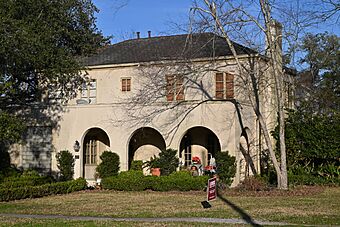 |
|
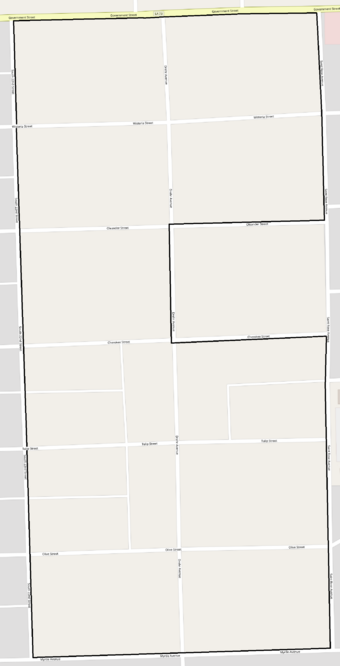 |
|
| Location | Roughly bounded by Government Street, South 22nd Street, Myrtle Avenue, and Saint Rose Avenue, Baton Rouge, Louisiana |
|---|---|
| Area | 37 acres (15 ha) |
| Built | 1919 |
| Architectural style | Tudor Revival, Bungalow/craftsman, Classical Revival |
| NRHP reference No. | 97001422 |
| Added to NRHP | November 13, 1997 |
The Drehr Place Historic District is another important part of the Garden District. It is located near Government Street and South 22nd Street. This area covers about 37 acres (15 ha). It has many historic homes, mostly one or two stories tall. The Sanders House on Wisteria Street is a notable home here.
The homes in Drehr Place were built between 1921 and 1947. The district started in 1919 when Alvin L. Drehr bought the land. It was officially named Drehr's Place by the 1920s. This district was added to the National Register of Historic Places in 1997.
Kleinert Terrace Historic District
|
Kleinert Terrace Historic District
|
|
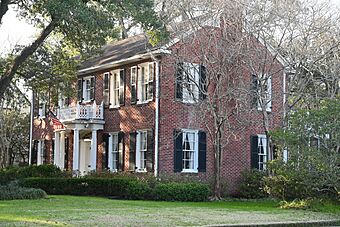 |
|
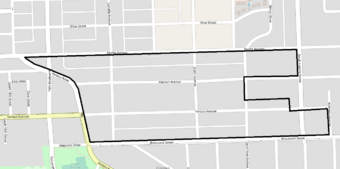 |
|
| Location | Roughly bounded by Myrtle Avenue, Perkins Road, Broussard Avenue, and South Eugene Street, Baton Rouge, Louisiana |
|---|---|
| Area | 60 acres (24 ha) |
| Built | 1927 |
| Architectural style | Colonial Revival, Tudor Revival |
| NRHP reference No. | 98000180 |
| Added to NRHP | March 5, 1998 |
The Kleinert Terrace Historic District is the third part of the Garden District. It is located near Myrtle Avenue and Perkins Road. This district covers about 60 acres (24 ha). It has many historic homes built between 1927 and 1947. Most of these homes are one or two stories tall.
Two very important homes in this district are the Pecue House on Myrtle Avenue and the Manship House on Kleinert Avenue. Kleinert Terrace was added to the National Register of Historic Places in 1998.
Images for kids


